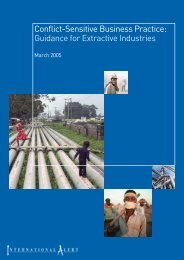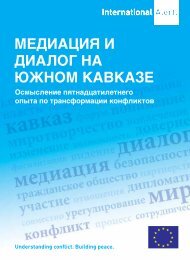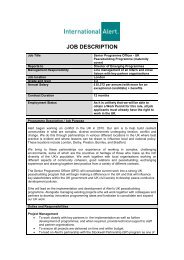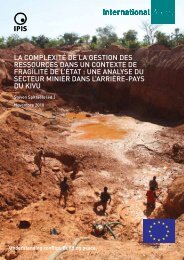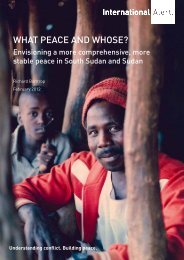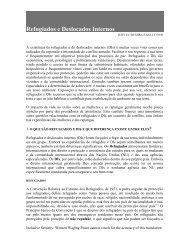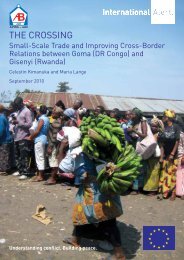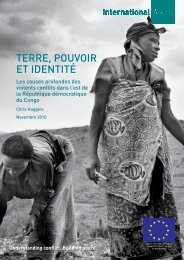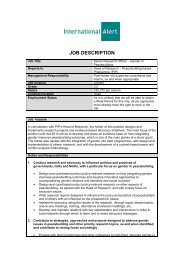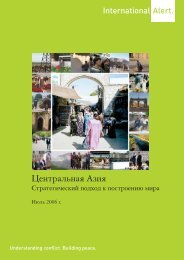The complexiTy of resource governance in a conTexT of sTaTe ... - Ipis
The complexiTy of resource governance in a conTexT of sTaTe ... - Ipis
The complexiTy of resource governance in a conTexT of sTaTe ... - Ipis
You also want an ePaper? Increase the reach of your titles
YUMPU automatically turns print PDFs into web optimized ePapers that Google loves.
<strong>The</strong> complexity <strong>of</strong> <strong>resource</strong> <strong>governance</strong> <strong>in</strong> a context <strong>of</strong> state fragility: An analysis <strong>of</strong> the m<strong>in</strong><strong>in</strong>g sector <strong>in</strong> the Kivu h<strong>in</strong>terlands<br />
61<br />
three <strong>of</strong> the h<strong>in</strong>terland areas and is similar to the situation <strong>in</strong> the Kivus, <strong>in</strong> that it is usually the<br />
local populations who suffer the brunt <strong>of</strong> the impact from armed extortion or worse.<br />
Despite serious human rights violations related to m<strong>in</strong><strong>in</strong>g activity be<strong>in</strong>g committed by both armed<br />
groups and the FARDC, it should be stressed that the security problem <strong>in</strong> the h<strong>in</strong>terland is not as<br />
complex as that <strong>of</strong> the Kivus, where several underly<strong>in</strong>g conflict issues are more important drivers<br />
<strong>of</strong> the behaviour <strong>of</strong> armed groups. None <strong>of</strong> the armed groups <strong>in</strong> the h<strong>in</strong>terland areas has put<br />
forward a real political agenda or <strong>in</strong>surmountable grievances.<br />
In the Kivu prov<strong>in</strong>ces, the armed conflict will not be solved by regulat<strong>in</strong>g the m<strong>in</strong>eral trade, and real<br />
development <strong>of</strong> the m<strong>in</strong><strong>in</strong>g sector is probably impossible as long as the conflict situation persists.<br />
<strong>The</strong>refore, it might make more sense to start develop<strong>in</strong>g the m<strong>in</strong><strong>in</strong>g sector <strong>in</strong> the h<strong>in</strong>terland,<br />
where it will be easier to re-establish state authority.<br />
In Northern Katanga, the FDLR has carried out a limited number <strong>of</strong> raids on small m<strong>in</strong><strong>in</strong>g sites<br />
and the FARDC shows predatory behaviour at several <strong>of</strong> the larger ones, especially <strong>in</strong> the territory<br />
<strong>of</strong> Nyunzu.<br />
<strong>The</strong> security situation is generally calm <strong>in</strong> Maniema and a large proportion <strong>of</strong> the m<strong>in</strong><strong>in</strong>g areas <strong>in</strong><br />
the prov<strong>in</strong>ce are free from military presence. <strong>The</strong>re are, however, some m<strong>in</strong><strong>in</strong>g areas where there<br />
is an armed presence, regular <strong>in</strong>cursions from armed groups, or extortions committed by army<br />
factions and civilian authorities.<br />
<strong>The</strong> relatively calm security situation <strong>in</strong> most <strong>of</strong> the h<strong>in</strong>terland <strong>of</strong>fers a real opportunity for<br />
<strong>in</strong>ternational due diligence efforts, as most <strong>of</strong> the m<strong>in</strong><strong>in</strong>g sites are outside conflict zones. <strong>The</strong>se<br />
efforts, as outl<strong>in</strong>ed by the Organisation for Economic Cooperation and Development (OECD) and<br />
US legislation, require companies to report whether their supply cha<strong>in</strong> conta<strong>in</strong>s m<strong>in</strong>erals sourced<br />
from conflict zones that could have contributed to the f<strong>in</strong>anc<strong>in</strong>g <strong>of</strong> armed groups. However, this,<br />
<strong>in</strong> turn, requires a mechanism to dist<strong>in</strong>guish between “clean” and “dirty” m<strong>in</strong>erals.<br />
As a first step, this dist<strong>in</strong>ction needs to be clearly def<strong>in</strong>ed, <strong>in</strong>clud<strong>in</strong>g tak<strong>in</strong>g a clear position on how<br />
to deal with the issue <strong>of</strong> human rights violations committed by soldiers <strong>of</strong> the Congolese army.<br />
Next, three complementary systems need to be created:<br />
• Certification at the source would be the most reliable way to identify conflict-free m<strong>in</strong>erals.<br />
Sett<strong>in</strong>g up a full system for certification is, however, a lengthy process. <strong>The</strong>refore, it could<br />
start with small islands <strong>of</strong> transparency. This is already happen<strong>in</strong>g at a limited number <strong>of</strong><br />
m<strong>in</strong><strong>in</strong>g sites <strong>in</strong> the Kivus under the coord<strong>in</strong>ation <strong>of</strong> BGR. Another pilot project is be<strong>in</strong>g run<br />
by the t<strong>in</strong> <strong>in</strong>dustry itself at two m<strong>in</strong>es <strong>in</strong> the Kivus. It is currently limited to sett<strong>in</strong>g up a<br />
system for traceability and has therefore been subject to criticism. Extend<strong>in</strong>g such <strong>in</strong>itiatives<br />
(or an improved version) to the h<strong>in</strong>terland is crucial and will most likely prove to be less<br />
complicated.<br />
As a full certification scheme is costly <strong>in</strong> terms <strong>of</strong> both time and money, an assessment has to<br />
be made whether the long-term strategies <strong>of</strong> donors to fight the “blood m<strong>in</strong>erals” phenomenon<br />
might be better focused <strong>in</strong>stead on support<strong>in</strong>g peacebuild<strong>in</strong>g <strong>in</strong>itiatives and defend<strong>in</strong>g human<br />
rights. It has to be kept <strong>in</strong> m<strong>in</strong>d that certification deals with the consequences <strong>of</strong> a certa<strong>in</strong><br />
problem, not the causes.<br />
• Neither due diligence nor certification are possible without the availability <strong>of</strong> complete and<br />
up-to-date <strong>in</strong>formation. <strong>The</strong>refore a rigorous mapp<strong>in</strong>g team should regularly chart out which<br />
m<strong>in</strong><strong>in</strong>g sites are occupied by armed groups. MONUSCO produces some <strong>in</strong>ternal maps every<br />
now and then and the US State Department has been obliged by its legislator to publicise<br />
maps, but both base their maps on exist<strong>in</strong>g <strong>in</strong>formation, primarily an IPIS map that dates<br />
back to the summer <strong>of</strong> 2009. Likewise, the DRC government has been work<strong>in</strong>g on a map<br />
<strong>of</strong> its own, rely<strong>in</strong>g on the US and MONUSCO maps. In short, although several map-mak<strong>in</strong>g





